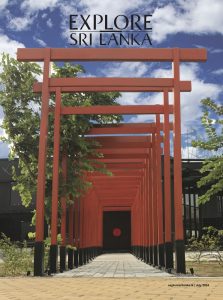
Haro Hara, Haro Hara… people chanted clasping their hands above their heads in fervent prayer. The air buzzed with the prayers and the accompanying melodies, which called upon the devout to join in the ensuing festivities. In all, the unfailing sound of the Nadaswaram vibrated through, matching each step of the pooja and resonating the message of this auspicious occasion.
Words Krishani Peiris Photographer Menaka Aravinda
Taking my shoes off at the entrance of the Manikka Pillayar Kovil, I walked in through the massive doorway, peering around while trying my best not to interrupt the people who were scurrying back and forth. All around me was abuzz with activity with the Kovil engaged in the last minute preparations of the Abhishekam – a pooja, which consists of pouring oblations such as milk, ghee and honey over a statue of the worshipped deity. The Manikka Pillayar Kovil dedicated to God Ganesh is decorated with beautiful sculptures and has ample space with more small shrines scattered around. Traversing the Kovil I observed the ensuing activities that surrounded me. Near the main shrine Loku Swamy, Sitsabesa Kurukal (Maniayyar), was tending the homam or the sacred fire. However, tracing my steps to the opposite side, I was at once enraptured by two people sitting on carpets, earnestly preparing some musical instruments. I awaited there, gazing upon the long wind instrument in the hands of one player… its unusual structure, the accompanying reeds and the clear melodies that greeted the ear, awoke my curiosity…
The Nadaswaram
Hailing from South India, the Nadaswaram is deemed to belong to the instrument family known as the Mangala Vadya – auspicious instruments – and is widely used in Hindu temples and weddings. It is also known throughout the world as the loudest non-bass acoustic instrument and is usually accompanied by a drum named the ‘Thavil.’ Traditionally made from a tree called Aacha, it is assumed that older wood gives better sound and longevity to the instrument. However, in modern times bamboo, sandalwood, copper, brass and ivory are also used in the making and the length of the instrument is about two and a half feet.
The player’s fingers moved over the finger-holes very deftly while he tried to maintain breath control in order to perfect the resounding notes.
Regarded as a double reed instrument, the Nadaswaram comprises of several parts and some believe that different parts of the instrument represent different gods of the Hindu religion. The topmost part is named the Mel Anaichu and a small metallic cylinder named Kendai is inserted here to fit the Seevali or the reed while the bottom part, shaped like a bell, is known as the Keezhu Anaichu and is believed by some to symbolise the Suryadeva or the Sun God. The long tube where the seven finger holes reside is considered by some to represent the seven mothers of Hindu mythology – Brahamani, Vaishnavi, Maheshwari, Kaumari, Varahi, Indrani and Chamunda. However, according to certain beliefs it is also assumed that the Nadaswaram exemplifies Lord Brahma – creator of the world, while the bore hole represents Lord Vishnu – the protector of the world and the melodious sounds known as Nada (music) embodies Lord Shiva.
The harmony that drifts by…
The stark beats of the Thavil signalled the beginning of the pooja and all around the Kovil gathered near the main shrine. Positioning myself, so that I could observe both the intriguing playing of the Nadaswaram and the pooja, I felt myself slowly being captured by the harmony that swirled, drawing me into the rhythm that encircled the periphery of the Kovil.
Haro Hara…the Nadaswaram rose to a magnificent pitch matching the prayers and the devotion…
The Nadaswaram consists of seven finger-holes while the five additional holes at the bottom are utilised as controllers. Equipped with a range of two and a half octaves akin to the flute – the sound that arises is both intense and powerful. Unlike the flute, the technique used when playing the Nadaswaram involves not just the partial closing and opening of the finger-holes, but also breath control. As I stood there watching the Nadaswaram player labour through the beautiful notes that kept flowing out of the instrument I was indeed able to understand the complexity and the talent required to play this enchanting instrument. The player’s fingers moved over the finger-holes very deftly while he tried to maintain breath control in order to perfect the resounding notes. Stopping awhile, even as the Thavil played on, he wiped the sweat that had gathered around his brow before continuing on with the playing, showcasing the effort that it took to produce the intense sound that filtered through. At times slow and at times fast, the melodies flowed, accompanied by smooth transitions as the player poured his heart and soul into the music that he played.
Haro Hara… Haro Hara… and the Nadaswaram rose to a magnificent pitch matching the prayers and the devotion of the people that surrounded the Kovil. It rang through the Kovil like a voice singing aloud, offering prayers and praises, as if it was indeed trying to reach the gods that dwell in the heavens above. An instrument that requires much devotion and much emotion, it carried a sound that will linger upon the heart, enthralling the mind with its powerful and intense music while enabling many to understand the beauty that surrounds the Nadaswaram.
[nggallery id=261]





